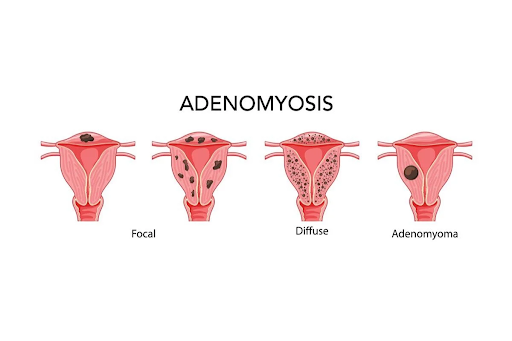Adenomyosis is a reproductive health condition in which the uterus’ inner lining, the endometrium, has breaks in the myometrium (the muscle wall of the uterus). It can cause lower abdominal pressure, menstrual cramps, and bloating before menstrual periods. And it can result in heavy periods. The condition can be present at one spot or throughout the whole uterus. As per experts at the best IVF centre in Bangalore, heavy bleeding and frequent pain associated with adenomyosis leave a negative impact on a female’s quality of life, even if it is not considered as a life-threatening condition.
Adenomyosis symptoms
Some females diagnosed with adenomyosis do not experience/notice any signs while some can experience signs like:
- Dysmenorrhea (painful and prolonged menstrual cramps)
- Menorrhagia (heavy menstrual bleeding)
- Abnormal menstruation
- Pelvic pain
- Dyspareunia (pain during sexual intercourse)
- Infertility
- Enlarged uterus
Adenomyosis causes
As per the available study findings, experts have no clear idea about why some females have adenomyosis. However, many reproductive health experts agree that this condition is more common in females who have already become mothers or delivered children.
Who is at risk of adenomyosis?
It is a common reproductive health issue among females who have children. Often, it occurs to or is diagnosed in women of middle ages. According to reproductive health experts, females with previous uterine surgery are at a higher risk of adenomyosis. The exact causes of adenomyosis are not clear. However, gynaecologists believe that hormones like progesterone, oestrogen, FHS, and prolactin may trigger it.
Adenomyosis diagnosis
Part from hysterectomy and uterine examination with a microscope, there were no other definitive ways to diagnose adenomyosis. However, the advancements in imaging technology have made the recognition/detection of adenomyosis without a surgery easier and convenient for doctors, especially reproductive health experts. With the use of transvaginal ultrasound and MRI, doctors can examine the lining tissue growth inside the uterus and confirm whether a female has adenomyosis or not. Here are some tests for diagnosing this condition:
- Physical examination – It is the first step when a doctor suspects of this condition. Through a pelvic examination, a doctor may know whether you have an enlarged and tender uterus or not.
- Sonohysterography – With it, doctors evaluate the symptoms of adenomyosis. In this examination, an expert uses a tiny tube to inject saline into the uterus based on the ultrasound guidance.
- MRI (magnetic resonance imaging) – Doctors recommend it to confirm adenomyosis when a female complains abnormal uterine bleeding.
Due to similarities in symptoms, there is misdiagnosis of adenomyosis as uterine fibroids. However, these two female reproductive health issues are different. In uterine fibroids, there is development of benign tumour in or on the uterine wall. But adenomyosis is the mass of cells within the uterine wall.
Suggest to Read:- Precautions During 4th month of Pregnancy
Adenomyosis treatments
Your adenomyosis treatment largely depends on what signs you experience, severity of the same, and test resorts. In the case of mild symptoms, doctors can advise you to take painkillers or apply a heating pad to ease what you are experiencing. Your treatment options can include:
-
- Anti-inflammatory medications – Your prescription may have NSAIDs (nonsteroidal anti-inflammatory drugs) to bring relief from mild pain. You need to take them one to two days before the beginning of your menstrual period and keep taking the same for the first few days of your period.
- Hormone therapy – Your doctor can prescribe hormonal therapies such as GnRH analogs, levonorgestrel-releasing IUD, and aromatase inhibitors.
- Uterine artery embolisation – It is a minimal invasive surgical procedure to cut off the blood supply to the adenomyosis.
- Endometrial ablation – Doctors use this procedure to destroy the uterine lining to make patients have relief from the issue if adenomyosis has not deep penetration in the uterine muscle wall.
Impact on fertility
Many females with adenomyosis have endometriosis. So, it is hard to state what role adenomyosis would have in fertility problems. However, many experts believe that untreated adenomyosis could make females infertile. Hysterectomy or uterus removal is the only definitive way to get cured from this condition.
Conclusion
Adenomyosis is an ordinary problem of the female reproductive system. Knowing its symptoms, causes, diagnosis, and treatment options will help you make a wise decision if you are suffering from it.




